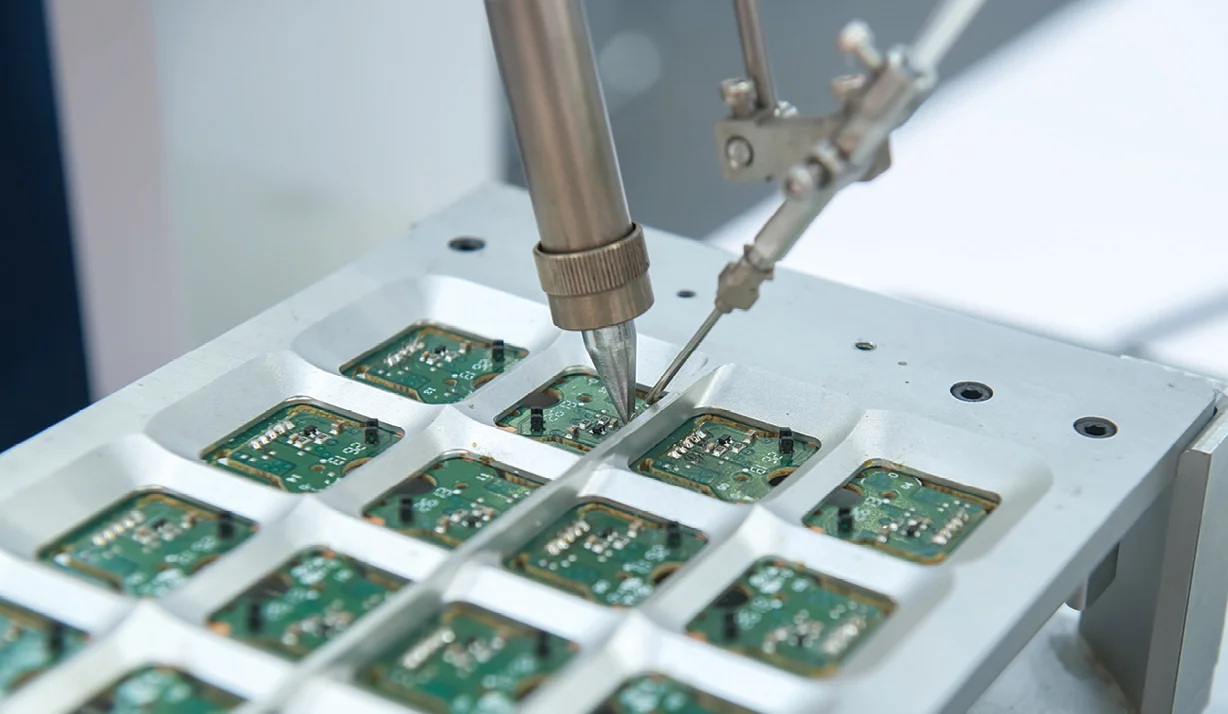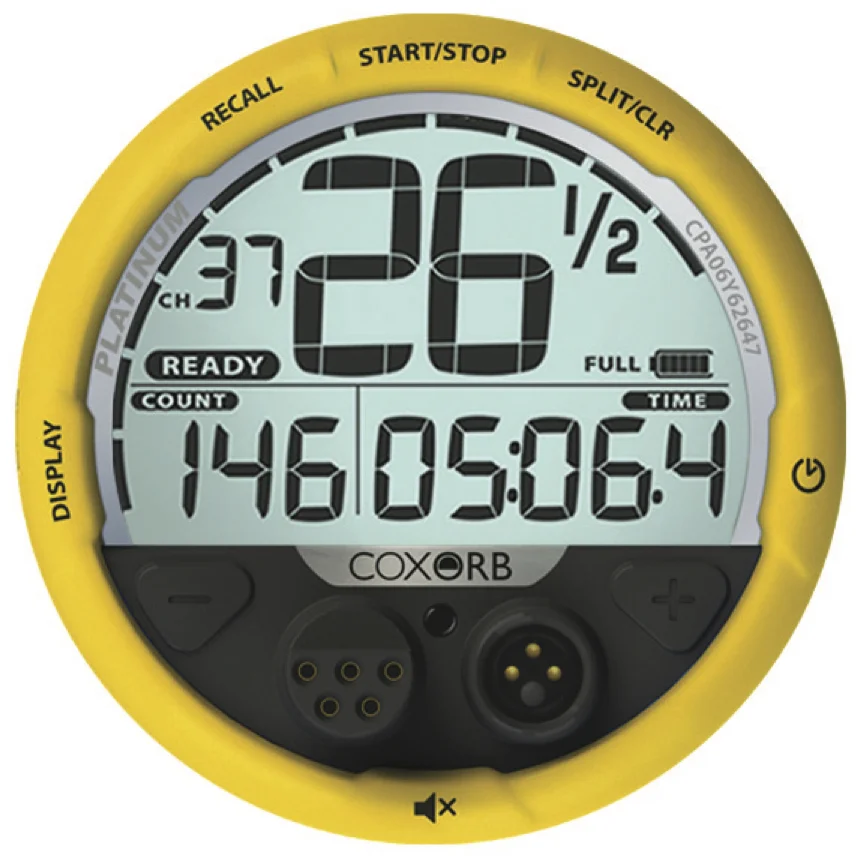If you answered “yes” to at least two of these questions, this article is for you.
Near the small town of Henley–yes, that one, Henley-on-Thames in England–is a production company that has taken the data and recording needs of coxswains to a new level. Active Tools founder John Ewans says that it was clear where there was a niche his company could fill, “It seemed obvious to combine all the electronics coxswains use into one device.”
Ewans’ company has been innovating products for rowers, coaches and coxswains since 2002. “We started with the span gauge,” Ewans explains, as we connect during a busy afternoon at his production facility. One of the most popular set of tools a coach can own, the self-centering span gauge, pitch gauge, and blade and pin measuring accessories that Active Tools makes are now nearly standard issue for modern rigging work.
“Then, ten years ago, we designed a coxing amplifier. The electronics were designed in Serbia, but the product was never finished.” This device, however, would stay in Ewans’ mind as his company dived into the world of adjustable rowing shoes and then into rate meters for rowers. Active Tools’ adjustable size rowing shoes are available as an after-market purchase, or standard on several boat manufacturer’s shells. Interestingly, their rate meters, although popular in England, didn’t catch on in the United States. Says Ewans, “The displays weren’t backlit, and that proved difficult in the US, where there are so many early-morning practices.”
Ewans, an industrial designer by training, says he “accidentally” started a design company. It was then natural for him–a rower since the age of thirteen–to focus on creating products for the sport he loved, always trying to improve on a known problem among rowers.
“We’ve always just tried out any good ideas that we had,” he says, in a British accent that has a hint of a Western drawl in it. “If we’d looked at the sport of rowing and tried to find a niche market that was viable–if we’d approached it like business people, which we weren’t–it would have been rowing electronics. That’s the market that is ready for development, and competition.” He hesitates here, knowing he’s speaking to an American. “The thing that’s missing in rowing is competition in the electronics market. If there’s no competition, there’s no growth.”
The idea of coxswain electronics–a microphone, boat speakers, a voice amplifier, GPS-based speed and course data, a recording device, an easy way to analyze the workout data collected during a piece–resurfaced to Ewans’ attention again, in early 2010, after the attempt he and his team had made ten years earlier. “We care about design.” Ewans’ understated British manner nearly masks his passion for clean lines and industrial functionality, but I can see his enthusiasm nonetheless.
“Can you describe an example of the design elements you innovated?” I ask, innocently.
“It started with a pink dog tennis ball,” he answers. I give him a quizzical look. “We knew that if we were going to have a new piece of coxing equipment embraced, it had to fit in the older cockpit cups, and it needed to have more features built-in. So, we started with a dog tennis ball, the over-sized kind you throw for your pup, and built the unit to be spherical on the backend, so it could not only fit into the cup, it was completely adjustable, so coxswains can angle it any way they need.”
He goes on, “We designed user-replaceable parts, to keep it from needing to be shipped back to the factory. A bigger display. Longer battery life.” Indeed, Active Tools–a design company with the purpose of innovation in rowing–studied the common pitfalls and, as they had done with their rigging tools and adjustable shoes, set out to improve on the things the current technology lacked.
“We aimed to make the best, most affordable product for coxing,” he explains. What resulted, after two years of development “from idea to boat,” was the CoxOrb. Priced just slightly above their competitor, Active Tools’ CoxOrb integrates the functions of your mic, amplifier, split and speed display, voice recorder and GPS device. It is sealed in a waterproof unit that automatically records your calls for every timed piece, stores your crew’s speed, split and meters per stroke data for the twenty most recent pieces, and even records GPS data to map the route you steered.
CoxOrbs come with a USB cable to transfer the collected data to your computer, and the company’s website offers a free Excel add-on that automatically plots your data into swanky graphs even the techiest geeks among us will love.
“The biggest complaint we’ve received,” Ewans reveals, “is that the Platinum CoxOrb is too complicated; it does too many things.” And so, back to the quiz at the beginning of this piece. If you are a technical cox who can’t get enough data or recordings or graphs to analyze and dissect, this might just be the next unit to ask your coach for.
CoxOrb has over half of the United Kingdom market, but, as Ewans knows, “the people who spend money on coxing amplifiers aren’t coxswains. The money is in the coach’s and club’s pockets."
Sales are growing in the US, and you can hear the difference. “The audio cable we use is the same cable used by musicians on concert stages,” he says. The concert-quality audio cable is so rugged, they guarantee it can be bent to 90-degrees 120,000 times without breaking. But the magic of their audio clarity is in their speakers. “If a boat goes past you with four Active Tools speakers, you can tell its ours.”
Ewans and I talk about the difference between designing a product to ameliorate the problems coxswains create and asking coxswains to change their behavior. “The design seems to be right,” he says, “from what people are telling us.” He smiles. “They are beloved, actually.” He goes on, sharing the darker side of design. “Electronics look easy, but getting them to work reliably in wet environments when they are being used by lots of different people who perhaps aren't always as careful is much harder than it looks. For instance, we make our own microphone connector by casting custom-made gold plated pins into our own molding and so far we haven't had a single connector fail.”
Ewans arranged for a demo unit to be shipped to the office here at Coxing Magazine and we gave it a test ride in several practices. Everything he had said was true. The data collection capabilities were significant. The Excel download macro produced graphs that let us see the correlation between strokes per minute and distance per stroke, plus a complete data set for each piece we did. The voice recording was clear and easy to access. The audio quality surprised the rowers, “Did you change something?” they asked, when we came back to the dock. “You sounded different, better.” And, the Platinum model was, indeed, complicated. I wished for one less item on the display, one less thing to think about. The good news is, once I learned to start the timing (which was simple), the data and voice recording happen automatically. It was the controls that dumbfounded me. I don’t like to admit it, but I found I had to read the manual to figure out the control buttons! After thirty minutes of self-education, though, I was hooked.
Ewans, in a call after the demo period was over, told me that many people feel that way. Luckily for people like me (a self-proclaimed middle-of-the-road techie), there are ways to get comfortable with the extra abilities of the CoxOrb. First, the display itself can be tailored to suit an individual’s desired output. Or, if you’re not in the market for the features of the GPS, a less intricate model of CoxOrb is available.
There are four levels of CoxOrb: Platinum, the powerhouse unit that’s GPS-enabled and has a built-in voice recorder; Tungsten, the next unit in line, no GPS but it does have voice recording; Cobalt, the simplest version, displays stroke rate, timing and stroke count and stores up to 2 GB of data (as they all do); and Steel, an amplifier-only version. All of the CoxOrbs have been impact tested for repeated drops onto concrete from a four-foot height and the battery life is listed as five to six hours. From our tests, the battery really did last that long, and that little buggar was rugged enough. One thing became true for me: once I had experienced the ease of voice recording the automatic CoxOrb-way while using the demo unit, I wished for it all season long.
Using a CoxOrb was a ton of fun, if for no other reasons than the clear audio in the boat and the automatic recordings to review my calls after practice. And, it felt good to have a choice of coxing units. Funny thing about our sport: we like choice, and, if the rowing shell market is any indication, having competition in an equipment category will nudge the products closer to the streamlined yet uber-functional units we all crave. CoxOrb has moved the coxswain's cockpit forward. We can’t wait to see what’s next. -JW
Complete CoxOrb details are available at active-tools.com







